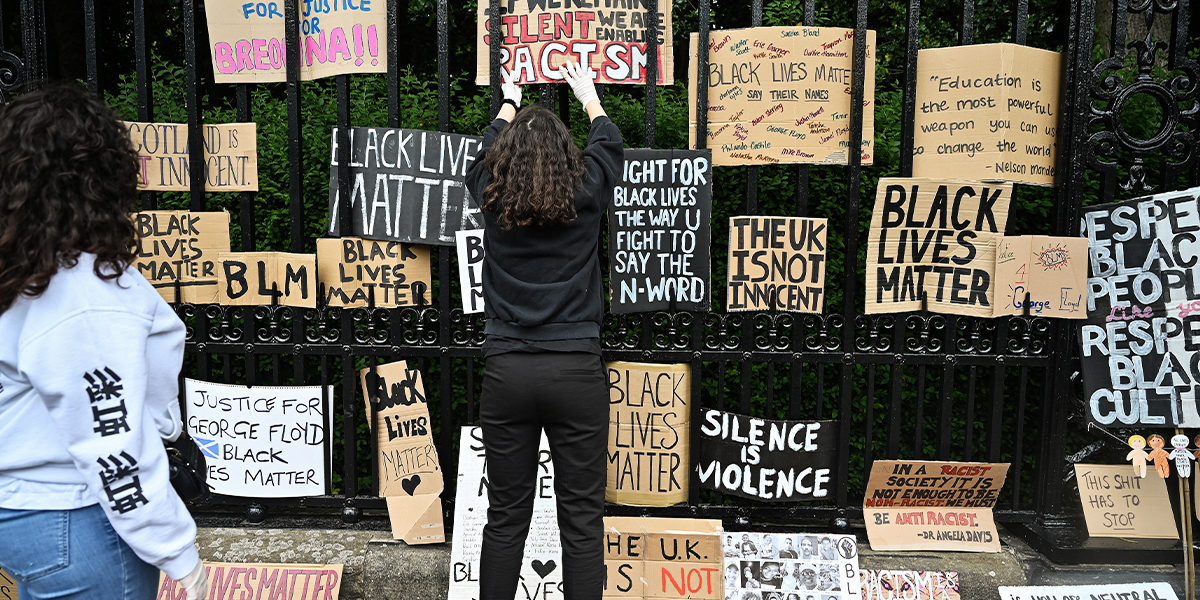What’s the best way to stay on top of the experience economy? Experience it all in one place. Liquid Dispatch X, your go-to consolidated source for brand experience, employee experience and customer experience. Take a look at the trends, the wins, and the ins and outs of what it takes to keep your most valuable and visible asset—your brand—running strong.
June Article Roundup
How brands are listening to customer and employee concerns of racial injustice.
The protests demanding justice for the death of George Floyd, Ahmaud Arbery, Breonna Taylor and countless others have jump-started a much-needed dialogue about racial injustice. This uprising has prompted companies in every industry to commit to creating a more equitable experience for customers and employees alike. That’s why we’ve curated a list of articles that illustrate how the “best practices” no longer cut it and how brands across the board are standing up in support of the Black Lives Matter movement like never before.
TOP PICKS
JUNE ARTICLES
BRAND EXPERIENCE

A Regularly Updated Blog Tracking Brands’ Responses to Racial Injustice—AdAge, AdAge Staff @AdAge
“Nonprofit Courageous Conversation Global Foundation has taken out a full-page ad in the Oklahoma Eagle, one of the oldest Black-owned publications in the U.S.—but it’s not just an ad. The page, which reads ‘Being Black is not a crime’ in all-white type against a black background, is also meant to serve as a sign for those planning to peacefully protest in Tulsa, Oklahoma, where President Trump is holding a rally, marking his return to the campaign trail after the pandemic had put it on hold. It's the latest in Goodby Silverstein & Partner’s work for CCGF.”

Nike Says “Don’t Do It” When it Comes to Racism in Reaction to George Floyd's Death—AdAge, Adrienne Pasquarelli @AdAge @SheLikesToShop
“On Friday evening, the Beaverton, Oregon-based brand released a 60-second spot on its digital channels. In stark white text over a black screen, Nike tells consumers “For once, don’t do it. Don’t pretend there’s not a problem in America. Don’t turn your back on racism. Don’t accept innocent lives being taken from us.” The spot, “For Once, Don’t Do It,” encourages people to stop being silent and making excuses, and instead to be part of the change.”

Nike’s “Don’t Do It” Anti-Racism Ad Receives Mixed Reviews—AList, Nina Aghadjanian @alistdaily
“However, Nike’s most recent anti-racism ad has drawn mixed reviews, sparking criticism on social media. While the video received praise from some celebrities, like rapper Travis Scott, one user lambasted Nike for the lack of diversity at its company. For example, Cindy Gallop tweeted: Hey @Nike, 'Don't pretend there's not a problem in America.' Not one Black person on your executive leadership team: https://about.nike.com/pages/executives… for a company that's made billions out of Black sports people and consumers. Change THAT. #DiversityAndInclusion #UntilWeAllWin.’”

Consumers Want Brands to Take a Moral Stand on Racial Justice—Adweek, Mónica Marie Zorrilla @Adweek @monicroqueta
“Report by Edelman reveals silence on racism is no longer an option. ‘This is a mandate for brands to act, because consumers will exercise brand democracy with their wallets,’ wrote CEO Richard Edelman in an essay issued by the public relations and marketing consultancy firm. ‘We have proven that brands can no longer dodge America’s original sin and third rail: systemic racism and inequality.’”

We’re Entering the Age of Corporate Social Justice—Harvard Business Review, Lily Zheng @HarvardBiz @LilyZheng308
“Corporate Social Justice is a framework regulated by the trust between a company and its employees, customers, shareholders, and the broader community it touches, with the goal of explicitly doing good by all of them. Where CSR is often realized through a secondary or even vanity program tacked onto a company’s main business, Corporate Social Justice requires deep integration with every aspect of the way a company functions.”
CUSTOMER EXPERIENCE

"Shopping While Black”: Yes, Bias Against Black Customers is Real—The Guardian, Cassi Pittman Claytor @Guardian
“Companies should also encourage customers to report incidents of discrimination, coaching them on how to do so effectively (making sure to include necessary details such as the date and time, sales person’s name, store branch, and so forth). Such data could help companies determine the scale and frequency of discrimination within their organizations and identify specific stores and sales associates that are serial offenders.”

Racism is Built into U.S. Cities Here’s How Architects Can Fight Back—Fast Company, Kimberly Dowdell @FastCompany @knd7
“In America today, we can predict that a person from a zip code in a black or Latino community will have a lower life expectancy than a person from a zip code that represents a primarily white community. How can we ensure that more communities extend their life expectancy? How can we expand the birthdays that get celebrated everywhere? We must pledge ourselves to truly design for life.”

Siri and Google Get ‘Black Lives Matter’ Right. Alexa, Not So Much—Fast Company, Jared Newman @FastCompany @OneJaredNewman
“The new responses, along with somewhat similar ones from Apple’s Siri assistant, show how ‘Black Lives Matter’ has at last become a mainstream way to acknowledge racism in America. They also highlight the fine line tech giants walk in building voice assistants that can answer any question. These companies have generally tried to avoid controversy, and it wasn’t long ago that they shied away from the topic of racial injustice entirely. Yet they’ve also presented their AI assistants as human-like conversationalists. That might prompt users to expect the assistants to have opinions, in a way that conventional search engines do not.”

A Call for Representation in CX—CustomerThink, Jeannie Walters @CustomerThink @jeanniecw
“And one enormous question we should all be asking: How can we deliver for all customers if our leadership teams lack the representation they need? This should trouble all leaders. Customer experience is ultimately creating how people will spend their time with your brand and product. How will your customers feel about those experiences? Are all customers asked for feedback? Is that feedback heard?”

Where the CX is Shifting in the Immediate Future—CMSWire, Phil Britt @CMSWIre
“Companies will have to get a grasp of how their brand is expressed in every end-user touchpoint and will need to ensure it reflects their values consistently and appropriately for every circumstance, from sales to instruction manuals to menus to customer service to invoices and receipts.”
“Employees, customers and clients will remember who treated them well during the crisis and they will be rewarded with loyalty from earning that trust during the bad times. We have learned that it is about touching people in meaningful ways which may mean being less busy, not more, for a while. Once we lay this groundwork it all will be in place to continue moving forward as the economy reopens and some businesses come back quicker than others.”
EMPLOYEE EXPERIENCE

Is Your Company Actually Fighting Racism or Just Talking About It?—Harvard Business Review, Kira Hudson Banks and Richard Harvey @HarvardBiz
“If your organization takes a stand against racism, you must also articulate how progress will be tracked and communicated back company-wide. Otherwise, you look untrustworthy and disingenuous. There’s no need for shame or guilt if your results are not glowing or swift. What has been given years to root will not be unearthed overnight.”

5 Ways to Approach Racial Equity at Work—PBS, Courtney Vinopal @NewsHour @cglennvino
“James added that managers and supervisors should think about how they can give their employees of color space to process the traumatic events—in both the short and long term—as they move forward. On the short term, for example, they can be more flexible with granting employees leave. In the long run, they should think about how they can ‘root out and eliminate the manifestations of structural racism’ in their office by supporting and promoting employees of color, diversifying their boards, and bringing in experts specializing in diversity, equity and inclusion to help them in doing so.”

One Black employee’s answer to “How can I help?—Culture Amp, Alicia Forneret @CultureAmp
“James added that managers and supervisors should think about how they can give their employees of color space to process the traumatic events—in both the short and long term—as they move forward. On the short term, for example, they can be more flexible with granting employees leave. In the long run, they should think about how they can ‘root out and eliminate the manifestations of structural racism’ in their office by supporting and promoting employees of color, diversifying their boards, and bringing in experts specializing in diversity, equity and inclusion to help them in doing so.”

5 Thoughtful Ways to Approach Discussing Racism at Work—Fast Company, Dynasti Hunt @FastCompany
“In organization-wide meetings, team meetings, and even individual conversations, once you’ve acknowledged what’s happening, don’t just leap into a discussion. It is important that you ask if Black people (not white people) if they would like further discussion space or not as not everyone is comfortable, ready, or simply wants to discuss at work. Plus, think of it this way: If you are a Black person who has eight meetings in a day and every meeting automatically opens with discussion, think about how exhausting and burdensome that can be.”

How to Improve Intercultural Relationships at Work: Five Ideas for Leaders—Forbes, Jeremy Pollack @Forbes
“Every Friday or the first Friday of the month, one individual brings in food for the entire team or department to share. The food is relevant to that individual’s personal background, and before eating, they talk briefly about where they first ate this type of food, who taught them to make it, a story about it from their family or culture, and what it means to them.”



